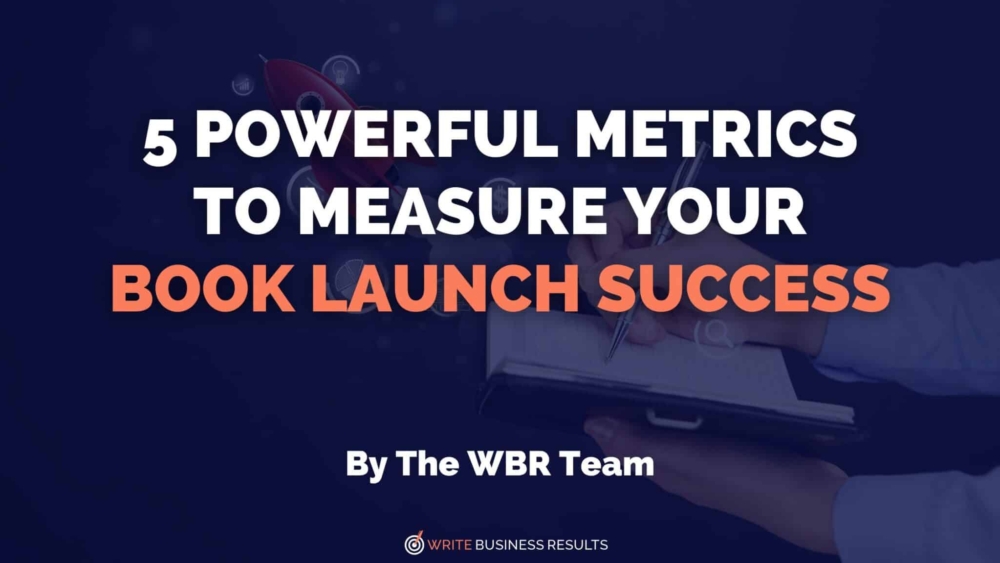By The WBR Team
The journey to publishing a business book always begins with a specific goal in mind. Maybe you want to accelerate your sales process, land speaking engagements, or generate brand awareness.
Regardless of the goal you have in mind, a successful book launch helps your target audience take the first step in the customer journey and nudges them along until they arrive at the ultimate goal.
This means that a successful book launch isn’t just measured by sales – it’s also measured by how well it supports each stage of the customer journey.
So, how do you measure the success of your book launch? Here are a few metrics you can track:
1. Amazon reviews
95 per cent of consumers read online reviews before purchasing any product, which is why book reviews are so important. Reviews are like a stamp of approval, encouraging other consumers to take the leap and buy your book.
Your first set of reviews will most likely come from your friends and immediate network who purchase and read the book and are willing to share their thoughts with other potential customers.
In addition to driving people’s purchase decisions, Amazon reviews can also serve as a form of social proof, which you can add to your website, social media posts, and all other pieces of content.
2. Media opportunities and coverage
With a new book, you can access new media opportunities which will further support the customer journey. While this media coverage won’t always translate to immediate book sales, it can create opportunities for you to build authority and increase your revenue in the long run.
Most authors typically aim for about ten media opportunities within the first few months of launching their book. If you can hit this target, you’re doing pretty well!
However, while securing media placements is a significant achievement, the real work begins with leveraging these opportunities to their fullest potential. Are you using these media placements to mine for prospects and nurture them? Are you leveraging them to build your credibility and authority?
Share your media appearances across your social media platforms, website, and email newsletters. This not only showcases your achievements but also extends the reach of the original media piece. It signals to your followers and potential readers that your work is recognised and valued by reputable sources.
You also want to treat each media opportunity as the beginning of a long-term relationship rather than a one-off event. Follow up with a thank you note, share the coverage extensively, and stay in touch with the journalists or influencers who featured you. Building these relationships can lead to more opportunities in the future and establish you as a go-to expert in your field.
3. Social media performance
As you promote your book through social media and other channels, you’ll be able to track which posts generate the most traction.
The more people interact with your content, the more visibility your book gets. This also means that you can analyse the more popular posts and learn what works best for your audience.
By understanding your audience’s preferences, you can tailor your email marketing, content creation, and even the rest of your book promotion to align with their interests. You can also use this information to design your services and courses, and effectively build a better customer journey.
This holistic approach ensures that from the moment potential readers encounter your book online to the time they make a purchase or sign up for a course, they’re engaged and motivated to explore what you have to offer further.
4. Lead generation
Lead generation is yet another powerful metric to gauge the success of your book launch. How many people moved on to the next stage of the customer journey?
By analysing the number of individuals who have taken specific actions – like subscribing to your newsletter or registering for a webinar – you gain valuable insights into the level of engagement and interest your book is generating.
Moving forward, you can then nurture these leads, eventually converting them into paying clients. Think about how you can support them with valuable, engaging content that keeps your brand top-of-mind.
By analysing, segmenting, and nurturing these leads, you’re not only boosting your immediate book sales but also laying the groundwork for a loyal reader base that will support your future projects.
5. Metrics linked to your personal goal
As we mentioned earlier, every entrepreneur who sets out to publish a book does so with a specific goal in mind. This goal is often personal, and it’s important to consider this when choosing the metrics you track.
While book sales are a conventional measure of success, they don’t always capture the full spectrum of an author’s goals. Some alternative metrics better suited to your goals might be:
- Audience engagement and growth
- People subscribing to the other resources you have
- Increased website traffic
- Network expansion
By identifying and focusing on the right metrics for YOU and you alone, you can gain a more nuanced understanding of how well your book launch has gone.
If you’d welcome professional help and support with building a holistic strategy for your book marketing campaign, book a Clarity Call today to find out how we can help.
